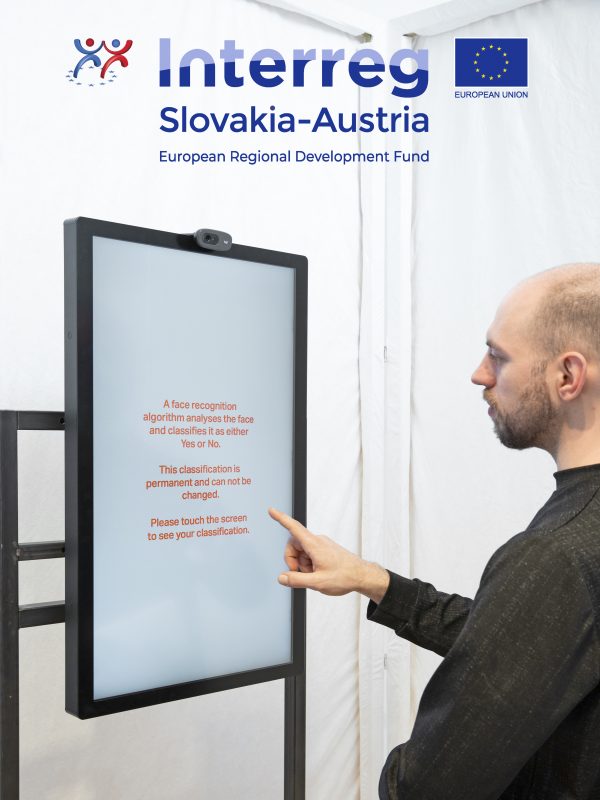The project „Design & Innovation“ focuses on crucial social issues in times of the digital revolution. Young artists from Vienna and Bratislava develop together in interdisciplinary design processes digital interventions which were exhibited at the MAK. In this talk Ruth Mateus-Berr, Ruth Schnell and Marlies Wirth reflect on the problems and potentials of digital art exhibitions. The project Design & Innovation is funded by the European Union program INTERREG V-A Slovakia-Austria.
Das Projekt „Design & Innovation“ widmet sich drängenden sozialen Fragen rund um die digitale Revolution. Junge Künstler*innen (Wien, Bratislava) entwickelten in einem interdisziplinären Designprozess digitale Interventionen, die im MAK zu sehen waren. Im Talk reflektieren Ruth Mateus-Berr, Ruth Schnell und Marlies Wirth über die Potenziale digitaler Ausstellungen. Das Projekt wird im Rahmen des EU-Programms INTERREG V-A Slowakei–Österreich Design & Innovation gefördert.
Artists: Artist Lucy Carrick, Barbora Krejcova and Pavol Soukal
Title: Old/New/Newer (Home Ed.)
Click to experience OLD/NEW/NEWER (Home Ed.)
The project reflects on the broad parallels existing between religion and Facebook, the largest social media network. At the end of 2018, the number of monthly Facebook users exceeded the number of followers of the world’s largest religion, Christianity. Facebook has become the largest communication tool for personal and professional interaction online. By combining texts from the bible with facebook’s terms of service, the project opens up a space to contemplate the impact that these two documents -and the ideologies they represent- have on our lives. The two texts overlap each other on the screen so that they are both illegible to the viewer. Until they step into the work or in terms of the current rendition of the piece until they turn on they’re web camera and begin to play around in this space. When exploring this new form of the work we wanted to look at these meeting rooms and the art we could create here with the nature of this medium and how this differs from the physical space.I the physical space we where able to observe the views behaviour some passive not stepping inside the installation or interfering with the projectors to find the mess others working together to fill the space and read the texts. This new medium has new set of conditions you you must accept. Move like befor but to play with lighting interact with others in the chat room in order to comprehend text.
Click to experience the digital OLD/NEW/NEWER (Home Ed.) by Artist Lucy Carrick, Barbora Krejcova and Pavol Soukal
Artists: Manuel Cyrill Bachinger and Ana Mumladze
Title: Yes/No Machine 2.0 @ AA collections Gallery at Reindorfgasse 9/2/R01 1150 Vienna
The Yes/No Machine is an interactive installation that explores the relationship between technology and the human body. A face recognition algorithm analyses the face and classifies it as either Yes or No. This classification is random, permanent and cannot be changed. What feelings are triggered by the classification? How much power and authority do we assign to such algorithms?
Manuel Cyrill Bachinger Based in Vienna, studies digital arts in the class of Ruth Schnell since 2017. His work focuses mainly on audiovisual and transformative processes and often manifests in installations and experimental forms.
Ana Mumladze Ana is a Vienna-based social designer focusing on placemaking performance and participatory artistic practice in public space, urban regeneration through art and sociality of food.
Artist talk with Artist and Social Designer Pavel Naydenov
Click here to explore the full artist interview with Pavel Naydenov about his art work and process.
“My life is not your porn” is a project-reaction to an urban phenomena started in South Korea, but today already spread around the world. It‘s about the hidden -cameras in public spaces.
“My life is not your porn” was a slogan created by protesters in Seoul, South Korea, on the fourth of August 2018. Over 70 000 people protested on the streets of the capital, most of them were women. The issue they were addressing was the increasing number of hidden cameras in public places (public toilets, changing rooms in stores, saunas or fitness studios, etc.) These cameras, often camouflaged as interior décor such as a picture frame, pin, vase decoration, knob, nail on the wall and so forth, have a very high resolution, able to catch details such as faces of protesting victims. The visual archive collected by the cameras is not only for private entities. The footage is often made public through uploads in the internet. Seoul has created a special police department, which deals with revealing hidden cameras and their owners. Since then, there have been 5 400 reported cases of hidden cameras, at least according to the official statistics. Unfortunately still today the verifiability of these crimes is minimal and perpetrators rarely fall under the power of the law—only 2 % of the cases in 2018.
The project aims to provoke public reaction and suspicion of such practices. “My life is not your porn” protests against the illegal digitized objectification of the human body. Pavel Naydenov is an artist and social designer based in Sofia and Vienna. In his works he deals with topics like public spaces, -collective memory, sexuality, subcultures, belonging. Often he works with found objects and images, archives, audio installations, and print-art.
Artist: Gabriela Urrutia Reyes
Title: They say / Dicen
What can we get of online discussions on social media? Does expressing our opinions online make any difference in the offline world? Why can’t we just hold back our thoughts? What do we accomplish when we enter into this online fighting loop?
When a discussion is really emotional and touches you, sometimes is very difficult to be rational and think on the consequences of your comments; but, could you really be quiet and not give your opinion? Could you be truly calm in a context that you feel you need to say something; because what the others are saying is maybe wrong, misleading, nonsense, false?
“They say”, sometimes is the way of receiving information in some countries, other times is the way we spread gossips and unverified news; but also, can be the action of reading all the comments that you can find on a topic from social medial that triggered many strong reactions
“The say” comments could take also another level of perception if you are living abroad, these comments, sometimes could become your way of being connected with certain topics of your home country, however, you don’t always know how to react towards these comments. Some questions arise as a person watching from the distance, what is true? What is not? Do I have the right to bring my opinion if I am not present in the country? Who do I believe? Which side am I taking?
Political, social and health crisis that societies have to undergo provoke in people a lot of stress, trauma, frustrations, and sometimes these emotions combined with the necessity of expressing what we think on social media, could create intense arguments if people disagree on their points of views.
Would you interact and debate online to cause reactions on others? Or would you only prefer to watch from the distance?
“They say” started as an interactive installation „DICEN“ at the Exhibition Human by Machine at the Museum of applied Arts Vienna (MAK), part of the EU program INTERREG V-A Slovakia–Austria.

